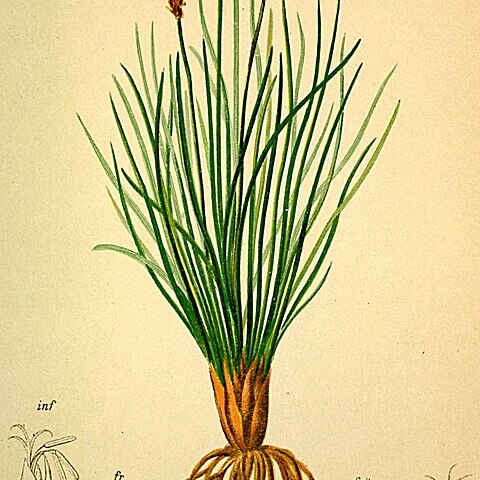Rhizomes short. Basal sheaths prominent and persistent, reddish brown to dark brown, dull or slightly shiny, margins and apices sometimes fibrillose, not retaining dried leaf blades. Culms densely tufted, erect, slightly stiff, obtusely trigonous or subterete, 3-30(-40) cm tall, 0.5-1 mm in diam. Leaves basal, shorter than or ca. as long as culms; blades stiffly erect, filiform (tubular in cross section), 0.25-0.7 mm wide. Inflorescence a dense spike, reddish brown to brown, narrowly cylindric, 1-3 × 0.2-0.3 cm, lowest spikelets sometimes slightly distant; lowest involucral bract glumelike, apex aristate or not; a few terminal spikelets male, others bisexual (lower ones occasionally female only). Bisexual spikelets with basal female flower and 1(or 2) male flowers. Glumes yellowish-or reddish brown to dark brown, with pale midvein, ovate or oblong-ovate, 2-4 × 1.2-2.7 mm, submembranous, midvein very narrow, margin broadly to not or narrowly hyaline, apex acute or rounded. Prophylls pale below, brown above, oblong or oblong-ovate, 2.2-3.5 × 1-1.4 mm, membranous, 2-keeled, keels slightly scabrid, margins free to lower 1/3 or nearly to base, upper margin hyaline, apex rounded or acute. Nutlets brown to dark brown, slightly shiny, oblong-obovoid, trigonous or flattened-trigonous, 1.8-3 (including beak) × 0.8-1 mm, shortly beaked, subsessile. Stigmas 2 or 3 (sometimes both on same plant). Fl. and fr. May-Sep. 2n = 56.
More
Culms 5–20(–35) cm. Leaves: basal sheaths somewhat glossy, bladeless; blades filiform, 2–20 cm × 0.2–0.5 mm. Inflorescences simple, 10–30 × 2–3 mm; proximal spikelets 2-flowered and androgynous, rarely 1-flowered and pistillate; distal spikelets 1-flowered, staminate. Scales brown, ovate, 2–3.5 mm, margins hyaline, midvein distinct almost to tip, apex obtuse or cuspidate. Anthers 1–1.5 mm. Perigynia brown, 2–3.5 mm, margins free to base, smooth. Achenes 2–2.8 mm. 2n = 52, 56–58.

